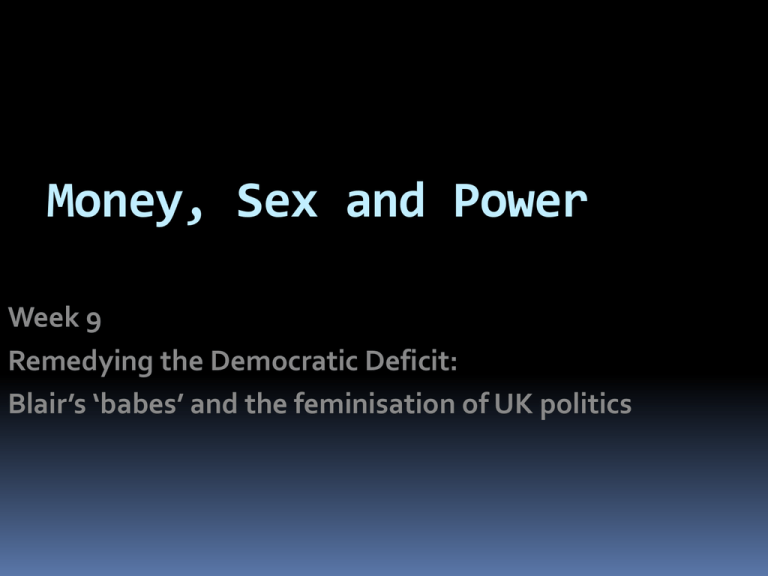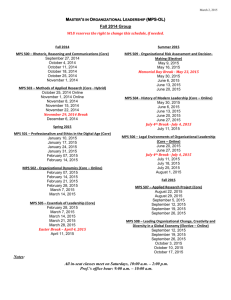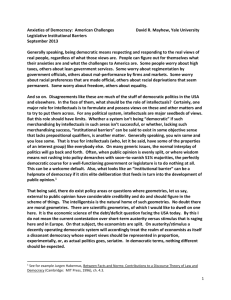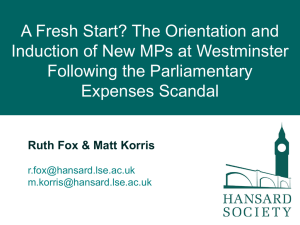
Money, Sex and Power
Week 9
Remedying the Democratic Deficit:
Blair’s ‘babes’ and the feminisation of UK politics
Lecture outline
The democratic deficit – what is it?
Does it matter who represents us?
What has been done to remedy the democratic
deficit?
Have women’s issues and concerns been
integrated into political life? Has politics been
feminised?
Democratic deficit – what is
it?
Political representatives don’t reflect the social
composition of the electorate
Representation complex concept
1. Symbolic
2. Delegate/representative
3. Demographic
Demographic representation important for idea of
democratic deficit
Demographic concept of representation
Composition of legislative assembly should reflect
composition of society/community – should
‘describe’ it
Like a statistically representative sample
Quantitative concept of representation
Assumes that members of social group are only
ones who can represent the interests of that group
(women, ethnic minorities)
Female suffrage
Campaigners argued that once women had vote
they’d be able to bring about change
Political equality would bring about other forms of
equality
A change in numerical representation would bring
about change in policies that affected women
Descriptive representation would lead to substantive
representation
Problems with descriptive
representation
No necessary link between social background/group
membership and political beliefs
If taken to extreme get situation where no one can
represent anyone else because don’t have exactly the
same social background
Despite this, elected assembly that’s unbalanced in
social composition still seen as less than democratic
Most legislative assemblies extremely undemocratic if
measured in this way
Unrepresentative UK Parliament
Age: average age of MP = 50 (Hackett and Hunter, 2010);
average age of UK population in 2011 is 39.7 (ONS, 2013)
Gender: women = 50+% of UK population but only 22% of MPs
Occupation: parliament is mainly middle class in terms of jobs
MPs have done. In 2010, only 4% of MPs have ever held a
manual job.
Education: 34% of MPs have had a private education
compared with 7% of UK population. In 2010, 20 MPs went to
Eton and 19 of these are Tories.
Ethnicity: 2011 Census, 14% of the UK population
belonged to non-white ethnic minority groups (ONS
2011). In 2010 parliament, only 4.1% of MPs were from a
non-white ethnic background. There are 15 ethnic
minority MPs in the Labour party, 11 in the Conservative
party and none in the Lib Dems.
Effects of women’s under-representation
1. ‘Unfinished democracy’ (Haavio Manila, 1985),
2.
3.
4.
5.
6.
simply undemocratic
Affects legitimacy of a democratic system, alienates
those who don’t people like see themselves in the
system (young people etc.)
Women and men may have different interests
Scope and form of politics restricted
Inefficient use of human resources
Socially unjust
What is to be done?
1. Do nothing and wait for time to take its course
2. Equality rhetoric
3. Equality promotion
4. Affirmative/positive action
All-women shortlists
In UK 1st past the post electoral system
Discriminatory and non-representative
compared with Proportional Representation
Women candidates often seen as an electoral
liability, given marginal seats
Gender divide reinforced by media, women’s
contribution trivialised
With PR more women would be elected
(Scotland and Wales)
Remedying the democratic deficit
Labour introduced women-only shortlists in 1993
Challenged in court by two male applicants
SDA 1975 ambiguous but challenge upheld
2002 amended SDA (Election Candidates) Act
Became legally permissible to take positive action
in selection procedures
Increasing the number of women
candidates
2015 - Important as SDA (Election Candidates)
expires
Result of all-women shortlists used by Labour was
that the number of women MPs increased
1997 proportion of women MPs went from 9% to
18%, 120 women MPs - ‘Blair’s babes’
2005 election - Lab 27.5%, Lib Dem 16.1%, Cons
8.6%
What differences have women made?
Domestic violence policy developed
National Childcare strategy
Other women friendly measures
Intervening on ‘women’s issues’
Does this imply a feminisation of politics?
Two possible interpretations
Feminisation of politics?
1. UK politics still male dominated and masculinised
(See Cowley, 1999 and Childs, 2001)
2. Has been a feminisation of UK politics, women
simply being there makes a difference (Ann
Phillips)
Voter turnout
UK seen a considerable drop in voter turnout
2001 general election 59.4% turnout, compared
with 2005 when there was a 61.4% turnout and
2010 with a 65.1% turnout
Younger people, working-class and ethnic
minorities more disillusioned with conventional
politics than white, middle-class, older people
Summary
Democratic deficit – political representatives don’t
reflect the composition of the population
This is important for equality and social justice
For women’s descriptive representation and that
of other minority groups to be translated into
substantive representation
And on grounds of legitimacy
Is politics feminised?
Little evidence of feminisation of politics
Political institutions are culturally masculinist
Institutionalise a particular form of masculinity
Some evidence that Wales and Scotland more
feminised












